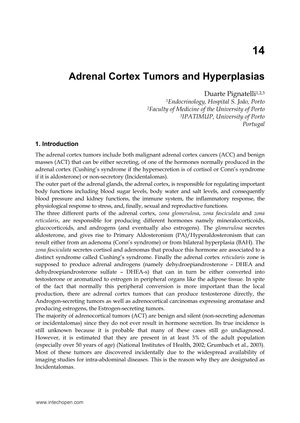Adrenal Cortex Tumors and Hyperplasias
November 2011
in “
InTech eBooks
”
adrenal cortex tumors hyperplasias adrenocortical tumors adrenal cortex cancers Weiss system IGF-II TP53 mutations Wnt signaling pathway ß-catenin mutations primary aldosteronism androgen-secreting tumors estrogen-secreting tumors Cushing's syndrome incidentalomas ACTH-independent hyperplasias cyclic AMP pathway AIMAH ACTH-independent micronodular hyperplasias bilateral adrenalectomy adrenal tumors adrenal cancers insulin-like growth factor II aldosteronism Cushing's

TLDR Most adrenal cortex tumors are benign and non-secreting, but proper diagnosis and treatment are important due to the rare possibility of cancer.
The document from 2011 provides a comprehensive overview of adrenal cortex tumors and hyperplasias, including benign adrenocortical tumors (ACTs), malignant adrenal cortex cancers (ACCs), and various hyperplasias. It notes that most ACTs are non-secreting and benign, found in at least 3% of adults over 50, while ACCs are rare with an incidence of 1-2 cases per million per year. The Weiss system is used to differentiate between adenoma and carcinoma, with malignancy indicated by meeting 4 or more criteria. The pathogenesis of ACC involves uncontrolled cell proliferation and genomic instability, with IGF-II overexpression observed in ACC. Genetic aspects such as TP53 mutations and Wnt signaling pathway involvement are discussed, with ß-catenin mutations common in adenomas. Clinically, 50-60% of ACCs are functional, causing hormonal syndromes. Imaging studies are crucial for tumor differentiation, and tumor size is a strong malignancy indicator. The document also addresses primary aldosteronism, androgen and estrogen-secreting tumors, Cushing's syndrome, and incidentalomas, emphasizing the importance of distinguishing between benign and malignant tumors for appropriate treatment. Pediatric adrenal cortex tumors and ACTH-independent hyperplasias are covered, with genetic mutations in the cyclic AMP pathway contributing to these conditions. Lastly, the document discusses AIMAH and ACTH-independent micronodular hyperplasias, including genetic mutations and clinical presentations, with bilateral adrenalectomy often being the treatment. The document does not provide specific study sizes, limiting the assessment of the strength of the studies mentioned.






